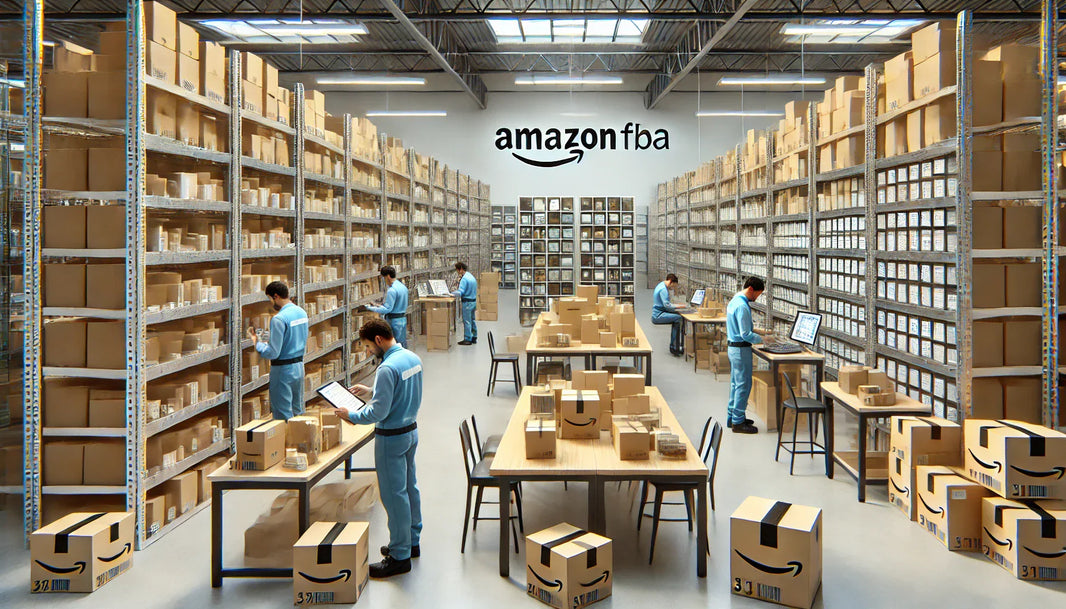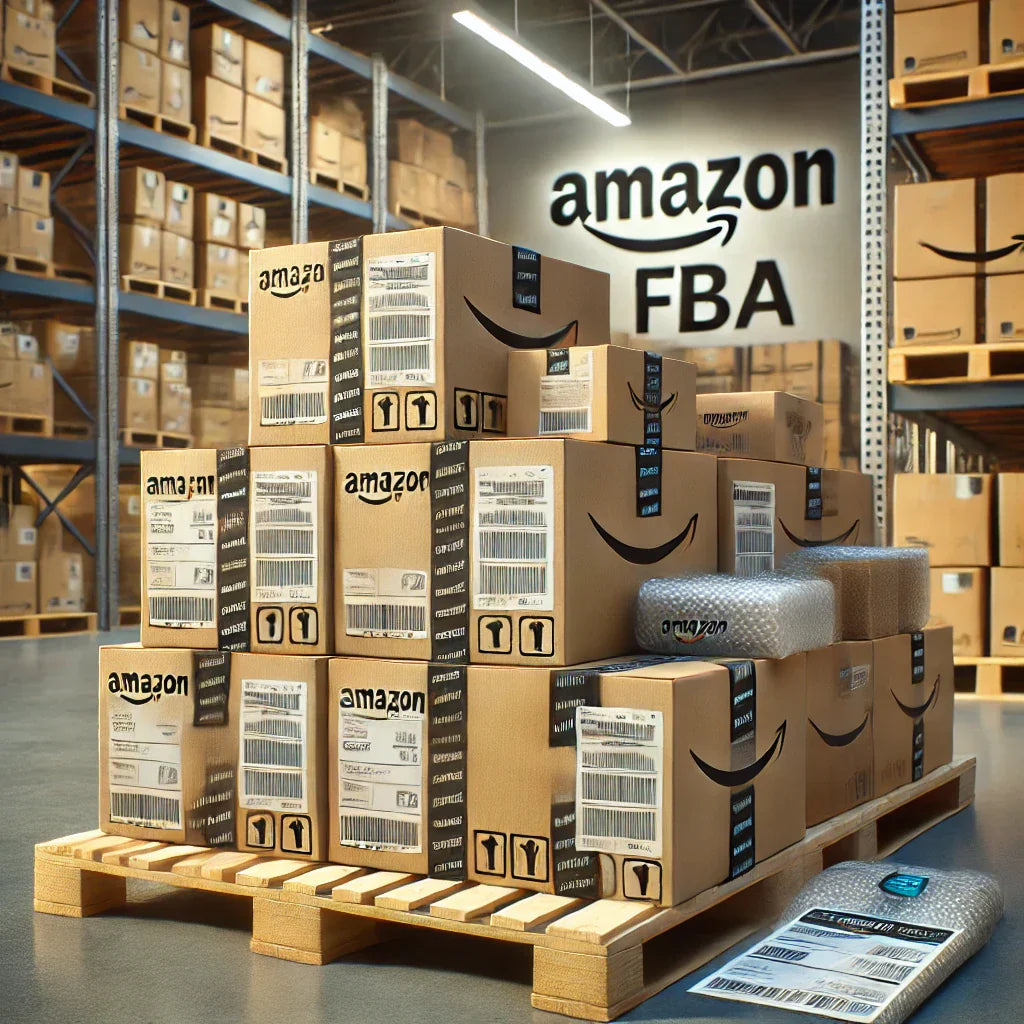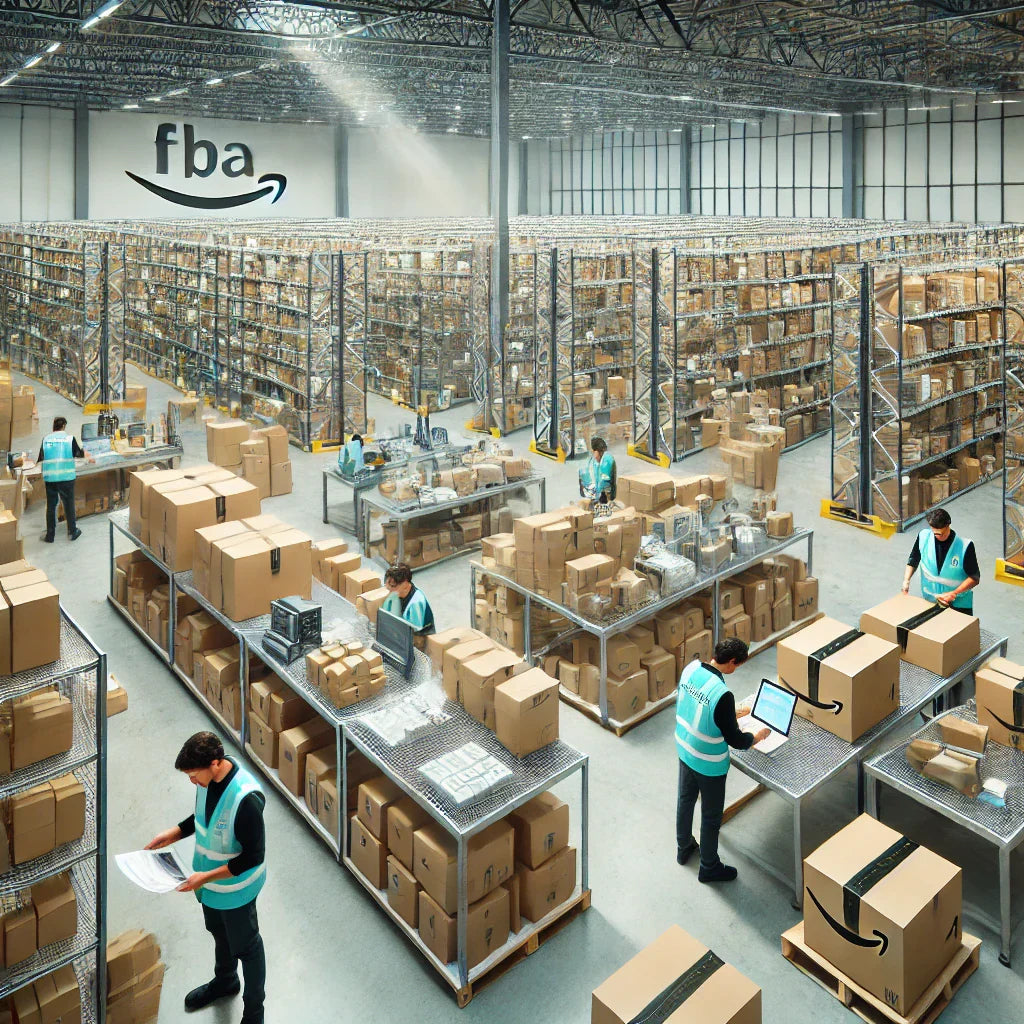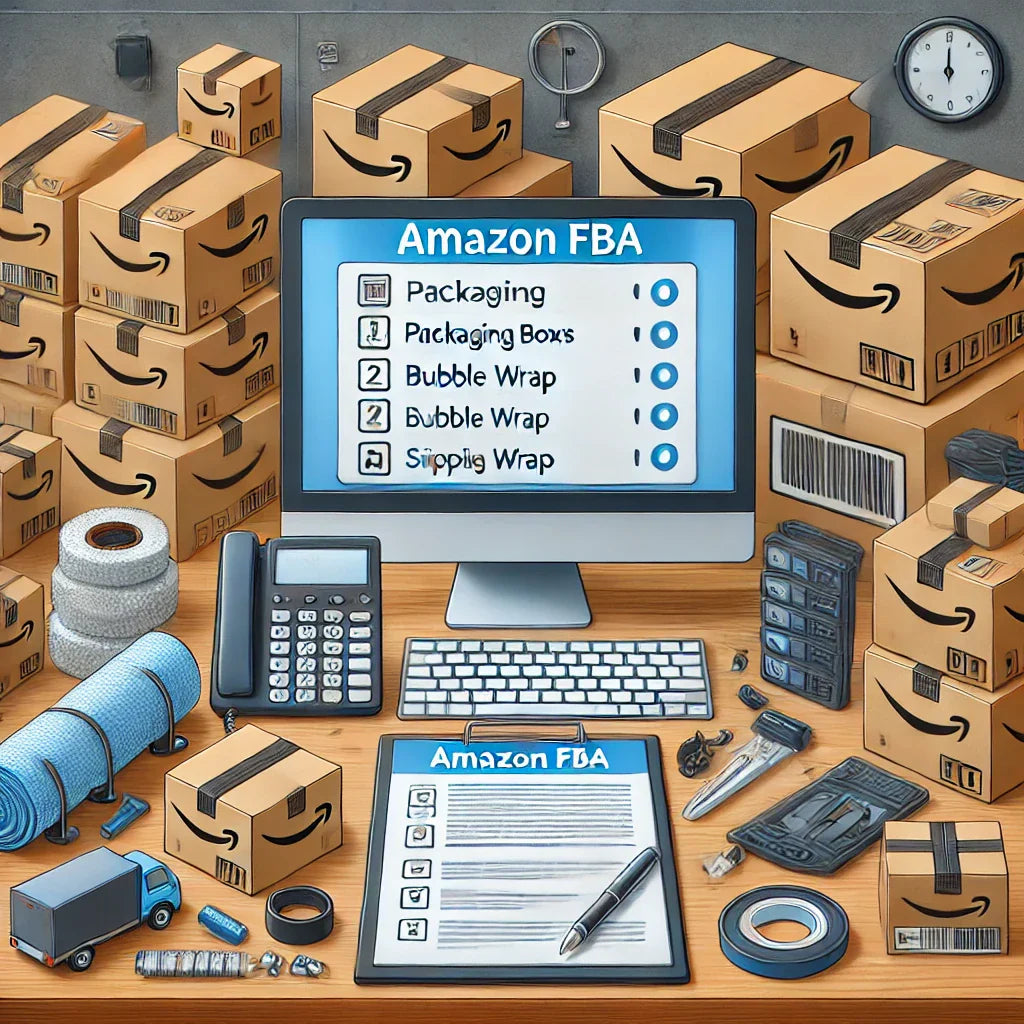Choosing the right Amazon FBA prep service is crucial for businesses aiming to streamline operations and meet Amazon's rigorous standards. As Amazon FBA sellers grow their inventory and customer base, ensuring smooth, compliant order preparation becomes increasingly challenging. A reliable FBA prep service helps manage complex fulfillment requirements, from packaging and labeling to storage and quality checks, allowing sellers to focus on scaling their businesses. This guide will explore essential factors in selecting the ideal FBA prep service tailored to your specific business needs, maximizing efficiency while ensuring adherence to Amazon's standards.

What is an Amazon FBA Prep Service?
An Amazon FBA prep service is a third-party provider specializing in preparing and packaging products for sellers who use Amazon's Fulfilled by Amazon (FBA) program. The prep center is responsible for ensuring that all items meet Amazon’s guidelines, covering various aspects like labeling, bundling, and packaging, so products arrive in Amazon’s warehouse ready for sale. Working with an FBA prep service means sellers can offload complex, time-consuming preparation tasks and focus on core business areas like product sourcing, marketing, and sales.
FBA prep services cater to a broad range of needs and business sizes. Whether you’re an established Amazon seller or just starting, understanding the types of services available and their benefits is essential for maximizing your business’s potential on the Amazon marketplace.
Key Benefits of Using an FBA Prep Service
- Time Efficiency and Streamlined Operations
- FBA prep services save significant time by handling critical preparation tasks. With the service managing compliance tasks, sellers can use their time more effectively, whether sourcing new products or optimizing listings.
- Expertise and Compliance with Amazon’s Standards
- Amazon’s guidelines can be intricate, covering labeling, packaging, and quality standards. Prep services have dedicated teams trained in these guidelines, ensuring that products meet requirements without errors that can lead to costly returns or delays.
- Cost Savings on Storage and Labor
- An FBA prep service allows sellers to cut down on storage expenses by having products shipped directly from the supplier to the prep center. Additionally, sellers avoid hiring extra labor, as the service handles all necessary prep tasks.
- Improved Inventory Management
- Some FBA prep centers offer additional inventory management services, such as warehousing, tracking, and stock level updates, giving sellers a comprehensive overview of their inventory to optimize restocking strategies.
Types of Amazon FBA Prep Services Available
Not all FBA prep services are alike. They cater to different product types and levels of complexity, allowing sellers to choose services that align closely with their specific business needs.
- Basic Preparation Services
- Basic prep services focus on essential preparation steps, including product labeling, packaging, and FNSKU (Fulfillment Network Stock Keeping Unit) application. These services are ideal for sellers handling standard items like books, apparel, or household goods.
- Specialized Product Handling
- Some sellers deal in products with unique preparation needs, such as fragile items, perishables, or hazardous goods. Specialized FBA prep services cater to these requirements with custom packing materials, temperature-controlled storage, and additional safety measures.
- Bundling and Kitting Services
- Bundling and kitting services allow sellers to create product bundles or kits, which can increase perceived value and drive sales. FBA prep centers offering these services are ideal for sellers looking to capitalize on unique product combinations.
- Full-Service FBA Prep Centers
- For sellers looking to outsource every aspect of inventory management, full-service centers provide end-to-end solutions. They handle warehousing, quality checks, packaging, labeling, and even shipping to Amazon warehouses, ensuring that sellers experience a hands-off approach to inventory management.
Factors to Consider When Choosing an FBA Prep Service
- Location Proximity to Amazon Fulfillment Centers
- FBA prep centers located close to Amazon fulfillment centers can reduce shipping costs and delivery times, a crucial factor for sellers looking to maximize efficiency. Shipping costs can accumulate, and choosing a center near key Amazon warehouses can make a significant difference over time.
- Pricing Structure and Affordability
- FBA prep service pricing varies based on factors like item complexity, storage duration, and service level. Sellers should assess their budget, considering the long-term costs and benefits. Some prep centers offer tiered pricing, which can be advantageous for sellers with fluctuating volumes.
- Turnaround Time and Speed of Service
- Turnaround time is critical, especially for sellers handling seasonal or high-demand products. Fast, reliable processing times ensure that inventory reaches Amazon warehouses on time. Checking reviews or contacting the service to understand their average turnaround times can help gauge efficiency.
- Quality Control Measures
- High-quality prep services invest in quality control measures to minimize errors. Ask about the center’s quality control processes, error rates, and policies on incorrect labeling or packaging. Reliable prep centers should have measures in place to guarantee compliance with Amazon’s standards.
- Additional Services
- Some FBA prep centers offer additional services like product photography, inventory tracking, or sales analytics. These features can provide added value, especially for sellers looking to streamline more aspects of their Amazon business.
Benefits of Choosing a Full-Service Prep Center
While basic prep services suffice for many sellers, full-service prep centers offer unique advantages for those handling large inventories or complex products.
- End-to-End Inventory Management
- Full-service centers manage inventory from the point of arrival to shipment, covering quality control, storage, packaging, and tracking. This level of oversight helps businesses optimize stock levels and keep customers satisfied.
- In-House Expertise on Packaging and Compliance
- Full-service centers employ teams specialized in Amazon requirements, minimizing errors related to incorrect packaging or labeling. This hands-on expertise ensures compliance with Amazon standards, reducing the risk of product rejections.
- Value-Added Services for Scaling
- Many full-service centers offer photography, custom packaging options, and even customer support. These features provide an all-inclusive experience for businesses looking to enhance brand perception and streamline operations.
How to Evaluate FBA Prep Service Providers
- Read Client Reviews and Case Studies
- Reading reviews from other sellers or asking for case studies can provide insights into the service’s reliability and accuracy. Case studies, in particular, showcase a provider’s performance and highlight the value added for businesses similar to yours.
- Request a Free Trial or Initial Consultation
- Some prep centers offer free trials or consultations. This approach allows sellers to experience the service firsthand, assessing quality, turnaround, and overall professionalism.
- Compare Pricing Plans and Service Flexibility
- Not all FBA prep centers have the same pricing structure. By comparing multiple providers and understanding their payment terms, businesses can better budget and avoid unexpected costs.
- Look for Established Industry Experience
- Choosing an FBA prep service with industry experience can ensure stability and knowledge. Companies with established expertise are often more adaptable to Amazon’s changing policies.

Common Challenges with FBA Prep Services and How to Address Them
- Communication Delays
- Some sellers experience communication delays with their prep services, leading to misunderstandings or delays. Choosing a center with dedicated account managers or a robust support team can alleviate this issue.
- Inconsistent Quality Control
- Inconsistent quality control can result in labeling errors or damaged goods. Ensuring that your chosen service provider has rigorous quality control measures can mitigate these risks.
- Unexpected Charges or Hidden Fees
- Carefully reviewing the contract for any hidden fees and asking upfront about additional costs related to storage or handling can help avoid unexpected expenses.
- Limited Service Capacity During Peak Seasons
- FBA prep centers may reach capacity during peak seasons, affecting service speed. Planning ahead and booking services early can help sellers avoid delays during critical sales periods.
Case Studies: Success Stories with FBA Prep Centers
- Case Study 1: Scaling with Efficiency
- A mid-sized seller in the electronics sector saw a 25% reduction in preparation times by outsourcing to a full-service prep center. By freeing up resources, the seller could focus on new product sourcing and expanding their product line.
- Case Study 2: Overcoming Compliance Issues
- A beauty brand struggled with frequent product rejections due to labeling errors. Partnering with a specialized FBA prep center resolved these issues, resulting in a 40% decrease in returned shipments.
- Case Study 3: Reducing Storage Costs
- An apparel seller partnered with an FBA prep center near Amazon’s main distribution centers. This proximity reduced overall shipping costs and allowed for flexible inventory management, ultimately saving the business 15% on logistics expenses annually.
When Should You Consider Switching Prep Services?
While many businesses benefit from their prep centers, there are times when changing providers is advantageous:
- Consistently Missed Turnaround Times
- If your provider is consistently slow, consider alternatives that guarantee faster processing. Turnaround time is crucial, especially for businesses with high turnover rates.
- Frequent Errors or Low Compliance Rate
- Low compliance rates lead to rejections and lost sales. If your prep service experiences frequent errors, switching to a service with better quality control might be beneficial.
- Inflexible Pricing or Hidden Fees
- Some providers may increase fees unexpectedly or lack flexible pricing plans. Switching to a service with transparent and flexible pricing can help manage costs effectively.
Practical Tips for Maximizing the Value of Your FBA Prep Service
Choosing an FBA prep service isn’t just about finding a company to handle compliance requirements; it’s about building a partnership that drives growth and profitability for your Amazon business. Here are practical tips to maximize the value of this collaboration:
- Clear Communication Channels and Set Expectations Early
- Set up direct, regular communication channels with your FBA prep center from the start. Arrange initial meetings to discuss service expectations, timelines, and any unique product handling needs. Establish a system for tracking updates on tasks like labeling and shipping to Amazon’s fulfillment centers.
- Implement Quality Assurance Checks on Both Sides
- Work with your prep center to set quality benchmarks. For instance, request photos of the products before shipment or an itemized checklist confirming all requirements are met. This strategy minimizes errors and allows you to catch issues before items reach Amazon, reducing the risk of costly rejections.
- Optimize Inventory Inflow Based on Sales Cycles
- Using insights from Amazon sales data, coordinate with your prep service to adjust your inventory prep based on demand trends. For instance, if you see a surge in demand for certain products during the holiday season, work with your prep center to ensure those products are prepped and ready ahead of time.
- Utilize Customization Options for Branded Packaging
- Custom, branded packaging can improve customer experience and enhance your brand identity on Amazon. Many full-service FBA prep centers offer packaging options, including inserts, custom boxes, or special wrapping. Discuss these options with your provider, especially if branding plays a key role in customer retention.
- Request Analytics on Prep Times and Error Rates
- Some advanced prep services provide data on their performance, like error rates and average prep times. These insights allow you to monitor efficiency and identify any trends that may need addressing. For example, if error rates spike, it might indicate that specific instructions need adjustment.
How FBA Prep Services Handle Common Product Types
Different products come with unique challenges, so it’s essential to ensure your FBA prep center is equipped to manage the specific requirements of your inventory. Here’s how FBA prep services commonly handle various types of products:
- Fragile Items and Breakables
- Fragile items, such as glassware, ceramics, or electronics, require additional care. Prep centers often use specialized packing materials like bubble wrap, foam inserts, or protective cases to secure items. Additionally, they may employ “drop tests” to ensure items are packed securely enough to withstand transit.
- Liquid Products
- Liquids require secure packaging and spill-proof containers. Most FBA prep centers have specific protocols for sealing liquid items to prevent leaks, often using shrink-wrap or special tape for added security. Amazon also has strict guidelines on how liquids are handled to avoid contamination with other products.
- Hazardous Goods
- Hazardous materials, such as batteries or flammable products, are subject to Amazon’s Hazardous Goods program. Not all FBA prep services handle these items, as they require additional safety compliance. Services that do handle hazardous goods usually follow strict labeling and packaging standards to meet both Amazon’s and transportation regulations.
- Perishable Items
- Perishables need temperature-controlled storage and expedited shipping. Some FBA prep services provide refrigerated or frozen storage options and special handling protocols to ensure these items remain fresh until they reach Amazon warehouses.
- Oversized and Bulky Items
- Prep services handling oversized items, such as furniture or large appliances, require specific equipment and space. These items are often prepped in warehouses with extended height limits and heavy-duty storage options. Discuss your product dimensions with the service provider to ensure they have the necessary capacity.

Advanced Strategies for FBA Sellers Using Prep Services
As your Amazon business grows, you may need to employ more sophisticated strategies with your FBA prep service provider. Here are some advanced tactics for scaling your FBA operations with the help of a prep service:
- Batch Shipments for Cost Efficiency
- Sending items in large batches instead of smaller, more frequent shipments can reduce shipping costs. Coordinate with your prep center to consolidate shipments based on predicted demand, which can also help lower costs related to packaging materials.
- Incorporate Cross-Docking for Faster Fulfillment
- Cross-docking is a logistics method where products are shipped from your supplier to the prep center and then immediately shipped to Amazon without prolonged storage. This approach minimizes storage costs and accelerates the speed at which your products become available on Amazon.
- Establish an Overflow Strategy with Multiple Prep Centers
- If you’re a high-volume seller, using multiple prep centers in different regions can reduce shipping times and costs. When one center is at capacity, overflow can be managed through another prep center to ensure that products are continuously stocked without delays.
- Use a Prep Center as a Backup for Inventory Management
- Treat your prep center as an overflow facility to back up inventory when your primary warehouse reaches capacity. This backup plan can be invaluable during peak sales seasons, preventing stockouts and ensuring customers can purchase items when demand spikes.
- Leverage Seasonal Prepping to Increase Sales During Holidays
- Plan holiday inventory well in advance, as peak seasons often create bottlenecks in FBA services. Some prep centers offer seasonal prep services, where you can reserve space and increase processing speed during high-demand periods, allowing you to take full advantage of holiday shopping trends.
Comparing FBA Prep Services: What Metrics Matter?
When comparing FBA prep services, specific metrics can help you assess each provider’s fit for your business needs. Here are the most important metrics to consider:
- Average Turnaround Time
- Turnaround time impacts how quickly products are available for sale on Amazon. Most prep centers have an average turnaround time of 2-5 days; however, seasonal changes may affect this. Confirm expected processing times to match your demand cycles.
- Error Rate and Quality Assurance Statistics
- Look at the service’s error rate and quality assurance procedures. Low error rates indicate the service has strong compliance processes in place. Ask about policies for dealing with prep mistakes, including any compensation for errors.
- Storage Fees and Capacity
- If you plan to use the prep center for warehousing, check their storage fees and monthly capacity. Some prep centers offer discounted rates for long-term storage, while others are optimized for quick turnover, charging higher fees for extended storage.
- Cost-Effectiveness Based on Product Type
- Cost-effectiveness varies based on product type and volume. Compare costs based on the average item prep fee and any additional charges specific to your product type, such as fragile item fees or bundling services.
- Customer Service Responsiveness
- Quick and effective customer service is crucial in FBA prep services, where delays or errors directly impact your sales. Test the service’s response time by reaching out with inquiries, and consider customer support ratings from reviews to gauge their responsiveness.
The Future of Amazon FBA Prep Services: Trends to Watch
As the e-commerce landscape evolves, FBA prep services are adapting to meet new market demands. Here are emerging trends in the FBA prep service industry that Amazon sellers should keep an eye on:
- Automation and AI Integration
- Some advanced FBA prep centers are integrating automation for tasks like labeling, sorting, and quality checks. Automation enhances accuracy and speeds up processes, allowing the service to handle higher volumes with fewer errors.
- Sustainability-Focused Packaging Options
- Eco-friendly packaging is increasingly in demand. Many prep centers are beginning to offer sustainable packaging options, such as biodegradable materials or recyclable packaging. This shift not only appeals to environmentally conscious consumers but also aligns with Amazon’s sustainability initiatives.
- Enhanced Data Analytics and Reporting
- Prep services are beginning to leverage data analytics for performance tracking. In the future, more centers are expected to provide detailed analytics on inventory turnover rates, prep efficiency, and error rates, giving sellers greater insights for decision-making.
- Expanded International Fulfillment Options
- As more sellers tap into global markets, some FBA prep centers are expanding their services to offer international shipping support. This trend allows sellers to prep and ship items directly to Amazon warehouses worldwide, streamlining global sales efforts.
- Customized Branding and Packaging Services
- With brand differentiation becoming more critical, FBA prep services are increasingly offering custom branding options, including logo placement and unique packaging designs. Customized packaging creates a memorable experience for buyers and can drive repeat sales.
Setting Up an Efficient Workflow with Your FBA Prep Service
A well-organized workflow with your FBA prep service is key to streamlining operations and minimizing delays. Here’s how to set up an efficient workflow that keeps your inventory moving smoothly from suppliers to Amazon warehouses:
- Establish Clear Inventory Intake Procedures
- Work with your prep service to establish clear procedures for receiving shipments from suppliers. Specify the types of documentation required, like packing slips or barcodes, and ensure each incoming batch has these essentials. Clear intake procedures prevent delays and help the prep service verify quantities and product types upon arrival.
- Use Digital Tools for Order Tracking and Coordination
- Consider using software solutions or project management tools that allow you and your prep service provider to track orders, provide updates, and record important notes. Many sellers use apps integrated with Amazon’s systems, such as InventoryLab, to manage stock levels and monitor shipments.
- Set Regular Check-ins and Progress Updates
- Schedule regular check-ins with your prep service team to discuss project status, upcoming shipments, and any concerns. Weekly or bi-weekly meetings can keep both parties aligned, allowing you to address any unexpected issues, especially during high-demand periods.
- Create a Backup Plan for Unexpected Delays
- Delays can occur due to high volume, seasonal rushes, or unforeseen events. Establishing a backup plan, such as prioritizing certain high-demand products, can help reduce the impact. Additionally, you might arrange temporary assistance from other prep centers if your primary provider is at capacity.
- Define Prep Priority Levels Based on Product Demand
- Communicate with your prep service to prioritize items based on demand forecasts. For example, products that are high-volume or in demand for upcoming promotions can be given priority in the prep queue, ensuring they’re shipped to Amazon on time.

How to Optimize Costs with Your FBA Prep Service
- Negotiate Volume-Based Pricing
- Many FBA prep services offer discounts based on order volume. Discuss pricing options with your provider and see if they’re willing to negotiate volume-based pricing as your order quantities increase. This arrangement often benefits both sides, as the prep service gains steady business, while you enjoy reduced fees.
- Reduce Unnecessary Prep Steps
- Depending on Amazon’s requirements, some prep steps might be optional. For example, if your items are already in secure packaging, you may not need additional protective layers. Speak with your prep center about avoiding redundant steps that add costs without adding value.
- Use Strategic Bundling to Lower Shipping Costs
- Bundling can be an effective cost-saving measure, especially when you have multiple small items that can be grouped together. By bundling products, you may reduce overall shipping costs and make your offerings more appealing to customers, who often perceive bundled products as better value.
- Monitor Storage Duration to Avoid Excess Fees
- While short-term storage at a prep center can be cost-effective, long-term storage fees can add up quickly. Try to keep storage times minimal by coordinating shipment timing and using demand forecasts to determine when products should arrive at Amazon warehouses.
- Consider Regional Prep Centers for Lower Shipping Costs
- Working with a prep center located near one of Amazon’s primary distribution hubs can save on shipping expenses. Proximity often means reduced shipping rates and faster transit times, particularly beneficial for businesses that rely on quick inventory replenishment.
Building a Strong Working Relationship with Your FBA Prep Service Provider
A positive relationship with your FBA prep provider fosters reliability and trust, resulting in smoother processes and fewer misunderstandings. Here are some ways to build a productive partnership:
- Be Transparent with Inventory Plans and Projections
- Keep your provider informed about upcoming inventory levels, especially during peak seasons. Providing forecasts and sharing any anticipated demand spikes or promotions ensures your provider is prepared to handle increased volumes.
- Promptly Address Issues and Provide Feedback
- Issues will inevitably arise, but handling them with open, constructive communication leads to faster resolutions. Provide timely feedback on areas where the service may need improvement, and recognize efforts when processes are smooth and efficient.
- Request a Dedicated Account Manager
- Some FBA prep centers offer account managers who handle communications, monitor progress, and address concerns. If your service provides this option, a dedicated account manager can help streamline your operations and address any issues quickly.
- Be Clear About Non-Negotiable Requirements
- If certain prep tasks or quality control steps are essential, make these non-negotiable points clear from the beginning. Documenting and communicating these requirements helps avoid misunderstandings and keeps standards consistent.
- Reward Positive Performance with Long-Term Contracts
- If your FBA prep provider consistently meets or exceeds expectations, consider offering a long-term contract. Many providers appreciate the stability of a long-term relationship, and you may even secure a discount for your commitment.
Integrating Inventory Management with Your FBA Prep Service
A well-integrated inventory management system helps you stay on top of stock levels, monitor product movement, and ensure timely replenishments. Here’s how to align inventory management practices with your FBA prep service:
- Use Real-Time Inventory Tracking
- With real-time inventory tracking, you gain immediate insights into stock levels and can adjust replenishment schedules accordingly. If your prep center offers tracking software, request access or consider integrating it with your own inventory management tool.
- Automate Low-Stock Alerts
- Set up automated alerts for when stock levels reach a minimum threshold. Alerts help you quickly reorder popular products or work with your prep center to increase prepping speed, especially during peak times when stockouts are more likely.
- Forecast Demand with Historical Sales Data
- Use historical sales data to predict demand cycles for each product. For instance, if certain items sell rapidly in the fourth quarter, align with your prep service to prepare these items in advance, ensuring stock availability as demand spikes.
- Utilize Barcoding for Streamlined Tracking
- Barcoding allows for easy product tracking, streamlining prep center intake and order fulfillment processes. If your products don’t already have barcodes, consider adding this feature to enhance visibility and facilitate easier handling.
- Implement FIFO or LIFO Strategies Based on Product Type
- Choose an inventory management method like FIFO (First In, First Out) for perishable goods, ensuring older stock is prepped and shipped first. For non-perishable items, LIFO (Last In, First Out) may be more suitable, depending on your storage strategy.
Case Studies: Real-Life Examples of FBA Prep Service Success
To illustrate how FBA prep services can drive business growth, here are a few real-life scenarios of how these services helped Amazon sellers achieve their goals:
- Case Study 1: Improving Efficiency for a Seasonal Product Seller
- A seller specializing in seasonal decorations faced challenges with long prep times and frequent Amazon stockouts during peak sales periods. By working with a full-service prep center and establishing a seasonal inventory plan, the seller reduced Amazon stockouts by 30% and increased overall sales volume during the holiday season.
- Case Study 2: Reducing Compliance-Related Returns for a Health and Wellness Brand
- A health and wellness brand struggled with compliance issues, leading to numerous product rejections. After switching to a prep service that specialized in handling health products, the seller’s compliance-related returns dropped by 45%. The prep center introduced custom labeling procedures to meet Amazon’s strict guidelines, resulting in smoother inventory intake at Amazon.
- Case Study 3: Expanding International Sales with a Global Prep Center
- A clothing brand wanted to expand into the European market but found the logistics complex and time-consuming. By partnering with a prep service that offered cross-border support, they could streamline the process of getting their products into Amazon’s European fulfillment centers. This move enabled the brand to expand its customer base and increase sales in new regions.
- Case Study 4: Cost Reduction for a High-Volume Electronics Seller
- An electronics seller handling large volumes of products needed to reduce shipping and storage costs. By consolidating shipments and strategically using a regional prep center near Amazon’s main distribution hubs, they reduced logistics expenses by 20% and improved their profit margins significantly.
Addressing Potential Pitfalls with FBA Prep Services
While FBA prep services offer many benefits, certain pitfalls may arise. Here’s how to anticipate and overcome some common challenges:
- Handling Inconsistent Quality
- Inconsistencies in product prep quality can lead to Amazon rejections, costing time and money. To address this, set up a quality control checklist with your provider, covering key areas like labeling accuracy, packaging, and item condition checks.
- Dealing with Delayed Shipments
- Delayed shipments can disrupt Amazon’s fulfillment process. To mitigate delays, ensure your provider has reliable shipping partnerships and backup plans in case of unexpected setbacks. Communicate with your prep center about the importance of meeting shipping deadlines.
- Navigating Hidden Fees
- Some providers may add hidden fees, especially for additional handling, storage, or specialized services. Clarify all fee structures upfront, and ask for a breakdown of any additional costs to prevent surprises.
- Managing Inventory Shrinkage
- Inventory shrinkage, or loss due to damage or misplacement, can be problematic, especially with high-value items. Implementing barcodes, tracking systems, and requiring accountability reports from your prep center helps reduce shrinkage and keeps stock levels accurate.
- Ensuring Scalability During Peak Seasons
- As demand surges during peak seasons, many prep centers face scalability issues. Arrange to increase your prep center’s staffing or resources.
Advanced Logistics Strategies for Streamlining FBA Prep Service Coordination
Effective logistics coordination with your FBA prep service can be a game-changer for managing large volumes and reducing handling times. Here are some advanced strategies to help optimize logistics with your prep center:
- Integrate a Direct Supplier-to-Prep Center Workflow
- By shipping products directly from your supplier to the prep center, you can eliminate unnecessary transit and reduce handling times. Setting up a supplier-to-prep-center workflow cuts costs on transportation and speeds up product availability on Amazon, especially beneficial for fast-moving or seasonal items.
- Implement Just-In-Time (JIT) Inventory Practices
- JIT inventory management can help keep prep center storage fees low. By closely monitoring sales patterns, you can time inventory arrivals to match sales, ensuring products are ready for Amazon when demand peaks without excessive storage times. JIT works particularly well for steady-selling products with predictable demand.
- Optimize Freight and Palletizing for Cost Efficiency
- For high-volume sellers, freight and palletizing costs can be substantial. Speak with your prep center about optimizing pallet configurations, such as using maximum load limits, to reduce the number of pallets shipped. This approach lowers freight costs and minimizes handling time at Amazon warehouses.
- Use Pre-Labeled Packaging to Cut Down Processing Times
- Pre-labeling products at the supplier level reduces the work required at the prep center. Suppliers can add Amazon FNSKU labels or other required identifiers to products before they arrive, allowing your prep center to expedite packaging and shipment to Amazon.
- Develop Cross-Docking Processes for Fast-Moving Items
- Cross-docking is ideal for high-demand items that need quick replenishment. In a cross-docking setup, items are immediately shipped to Amazon’s warehouses upon arrival at the prep center, reducing or eliminating storage time. This process speeds up restocking, making products available on Amazon quickly and improving overall customer satisfaction.

Best Practices for Managing Vendor Relationships in the FBA Prep Process
Building and maintaining strong relationships with your suppliers and prep center is essential to efficient FBA operations. Here are effective ways to manage these relationships:
- Establish a Communication Protocol with Suppliers
- Coordinate with suppliers to ensure timely communication, especially regarding shipment status, product specifications, and quality standards. Clear communication channels prevent misinterpretations and help your prep center work efficiently with the correct product specifications from the start.
- Set Up Service-Level Agreements (SLAs)
- Formalize your expectations with both suppliers and your prep center through SLAs. These agreements outline performance benchmarks, like acceptable turnaround times, labeling accuracy, and packaging quality, which help hold each party accountable and keep your operations running smoothly.
- Develop a Contingency Plan for Supplier Delays
- Supplier delays can impact your prep schedule and product availability on Amazon. Creating a contingency plan—such as having backup suppliers or rush prep services—minimizes downtime and ensures your prep center can maintain a steady flow of inventory.
- Negotiate Bulk Discounts with Regular Vendors
- Many suppliers and prep centers are open to discounts for regular, high-volume orders. Negotiating bulk discounts for large or recurring orders can lower your overall prep and product costs, increasing profitability.
- Use Vendor Management Software for Tracking and Communication
- Vendor management software helps keep all communication, order tracking, and documentation in one place. Software like SAP Ariba or NetSuite Vendor Management can help you manage order status, communicate effectively, and track key metrics across all partners.
Navigating Amazon’s Compliance Standards with Your FBA Prep Service
Staying compliant with Amazon’s FBA guidelines is a top priority. Non-compliance can lead to delays, fines, or even account suspension. Here’s how to ensure compliance with Amazon’s standards while working with your FBA prep service:
- Create a Comprehensive Compliance Checklist
- Work with your prep service to develop a checklist covering all of Amazon’s requirements for your specific products. The checklist should include labeling requirements, packaging specifications, and item quality standards, helping both you and the prep center adhere to Amazon’s compliance expectations.
- Conduct Regular Compliance Audits
- Schedule periodic audits with your prep service to review processes and verify that they align with Amazon’s requirements. Audits can identify any compliance issues before they escalate, reducing the risk of product rejections or account penalties.
- Stay Informed on Amazon’s Policy Changes
- Amazon frequently updates its policies, and staying informed ensures you don’t fall behind on new requirements. Many prep centers offer policy update notifications, but maintaining direct awareness through Amazon Seller Central and forums like Amazon Seller University is also helpful.
- Use Amazon’s Inventory Performance Index (IPI) as a Quality Metric
- Your IPI score reflects the quality and efficiency of your inventory management. A higher IPI score can indicate strong compliance and efficient processes. Discuss your IPI metrics with your prep center to improve factors that Amazon deems important, such as inventory turnover rates and in-stock levels.
- Ensure Proper Handling of Restricted and Hazmat Items
- Amazon has strict protocols for restricted and hazardous materials. Ensure your prep center is certified to handle these products and is up-to-date on relevant regulations to avoid disruptions. Non-compliance with hazardous materials handling could lead to costly delays or even account restrictions.

Conclusion
Selecting the right Amazon FBA prep service is a strategic decision that can significantly impact the efficiency and success of your e-commerce business. By choosing a provider that aligns with your business needs—whether through basic prep services, specialized handling, or full-service solutions—you gain a reliable partner in managing complex fulfillment tasks. This partnership not only frees up your time but also ensures compliance with Amazon's stringent standards, helping you avoid costly errors and improving your chances of success in a competitive marketplace.
Investing in a strong working relationship, setting clear operational guidelines, and continuously optimizing workflows with your FBA prep service can help you maximize profitability and maintain seamless inventory management. As the e-commerce landscape continues to evolve, a well-chosen FBA prep service provider will be invaluable in scaling your operations, allowing you to focus on growth, customer satisfaction, and expanding your presence both domestically and internationally.
Read More
- A Complete Guide to Amazon FBA Preparation: Essential Steps for Success
- Top Amazon FBA Prep Tips: How to Streamline Your Process for Maximum Efficiency
- Why Amazon FBA Prep Centers Are Crucial for Growing Your E-commerce Business
- Amazon FBA Packaging Guidelines: Key Requirements for Safe and Compliant Shipments
- The Cost of Amazon FBA Preparation: Budgeting Tips for New Sellers
- How to Avoid Common Amazon FBA Prep Mistakes: Expert Advice for Sellers







